In brief
- The Ledger Nano S Plus is the latest hardware wallet from Ledger.
- It sits in between the Ledger Nano S and the Nano X models.
- It sports a bigger screen than the Nano S, plus upgraded storage capacity.
Jump to
Since the Ledger Nano S was first launched in 2016, a lot has happened in the cryptocurrency world.
Bitcoin's price has gone from $700 to an all-time-high of nearly $70,000. Ethereum, then less than a year old, is now a mainstay of the crypto space, underpinning ICOs, NFTs, DAOs and other three-letter acronyms that have come to define cryptocurrency for the mainstream.
And through it all, Ledger's trusty little workhorse has trudged on, with millions of users trusting the hardware wallet to secure their private keys, squinting at its tiny screen as they send crypto to and fro.
Now, Ledger's best-selling hardware wallet is getting a long-overdue refresh. So what's new—and can it compete in 2022?
What is the Ledger Nano S Plus?
The Ledger Nano S Plus is an updated version of the French company's entry-level Ledger Nano S hardware wallet, with a refreshed design incorporating a larger screen and revised internals. The base level Nano S will be retired later this year, leaving the S Plus as the entry-level option for the range.
Priced at $79, the Nano S Plus sits neatly in between the $59 Nano S and the top-of-the-line Ledger Nano X, at $119.
In case you missed the news - the Nano S Plus is now available! 🎉
To celebrate, we’re taking you on a journey inside our latest device, so you can learn why it's so special.
Today we stop by Lacroix, the plant where our circuit boards are programmed: https://t.co/uq5fWzjmEF pic.twitter.com/qKmcUiUAw4
— Ledger (@Ledger) April 11, 2022
Ledger Nano S Plus: Design and Build
If you've seen a Ledger Nano wallet before, then you'll know what to expect. The hardware wallet resembles a chunky USB flash drive, with an aluminum shield that rotates to reveal the main body of the device. Although it's currently available only in black, Ledger will be releasing the Nano S Plus in different colorways later in the year, with options including white, red, blue and a translucent case.
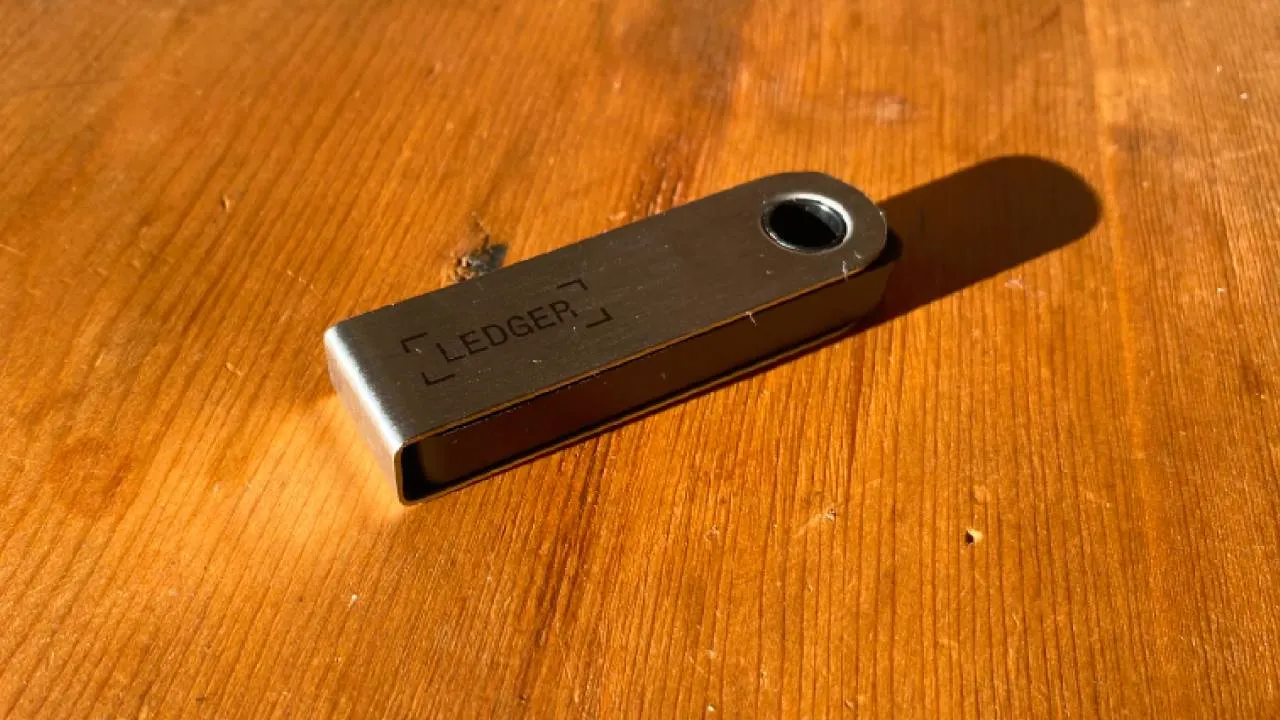
While it's no Jony Ive product design masterpiece, it's discreet, and it's a lot nicer looking than some of its rivals. Etched into the aluminum shield is Ledger's new logo, following a rebrand in late 2021; it's a bit slicker than the old logo, and more self-consciously "crypto."
The Nano S Plus sports a more curved design with rounded-off buttons. It also features a USB-C port, as seen on the Nano X, in place of the old micro-USB found on the Nano S.
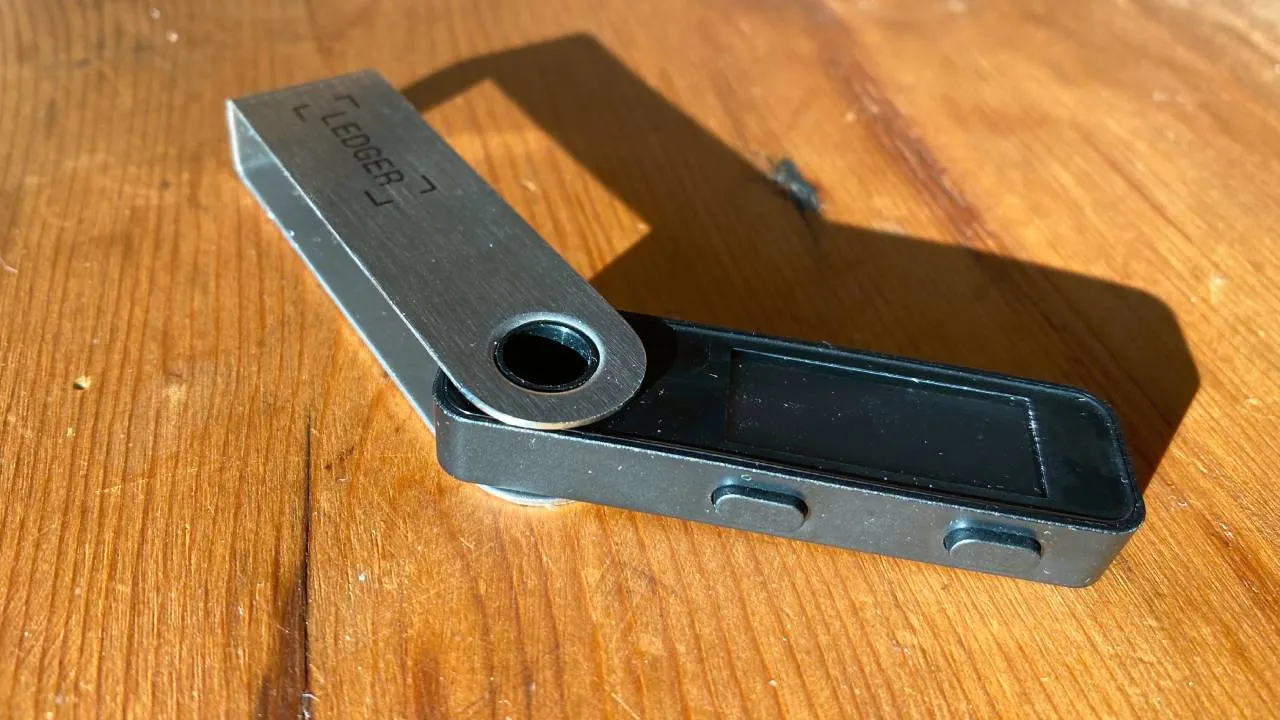
Most importantly, the Nano S Plus boasts a much bigger screen than the base model Nano S—the same 128 x 64 pixel screen found on the Nano X, in fact. At twice the height of the Nano S model's 128 x 32 pixel screen, that means no more scrolling through wallet addresses across multiple screens when trying to send crypto.
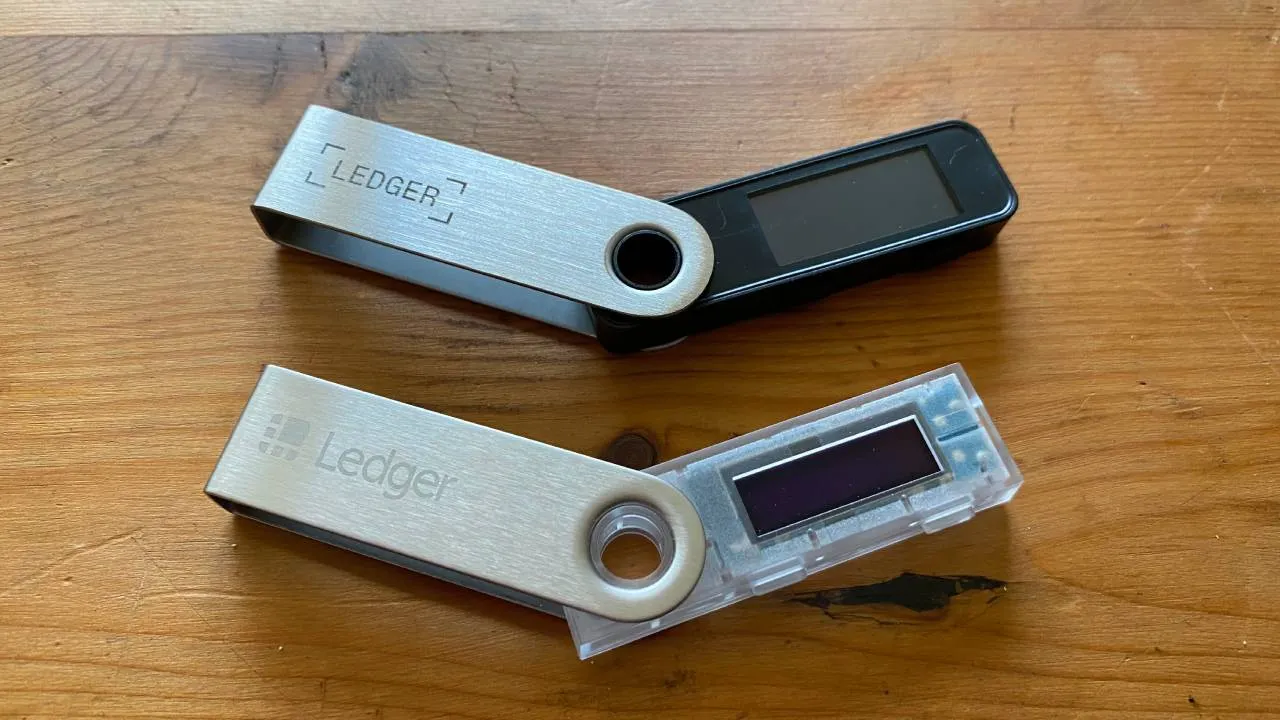
As Nano X users will know, it's also much clearer and sharper than the tiny, fiddly affair seen on the Nano S, with graphics and text rendered in crisp black and white, instead of blue and white.
Ledger Nano S Plus: What's in the box?
Since Ledger's rebrand it's abandoned the faux-Apple packaging in favor of a sleek gray-and-black affair. Ledger doesn't use an anti-tamper seal, arguing that they can be easily counterfeited and are misleading; instead, the box is shrink-wrapped.

Crack the packaging open and you're greeted with a quick start guide (which basically tells you to download the company's Ledger Live app), an envelope containing cards to record your recovery phrase, a USB-C cable, a loop for attaching your Ledger to a keyring, and the ubiquitous brand stickers found in every tech product box.
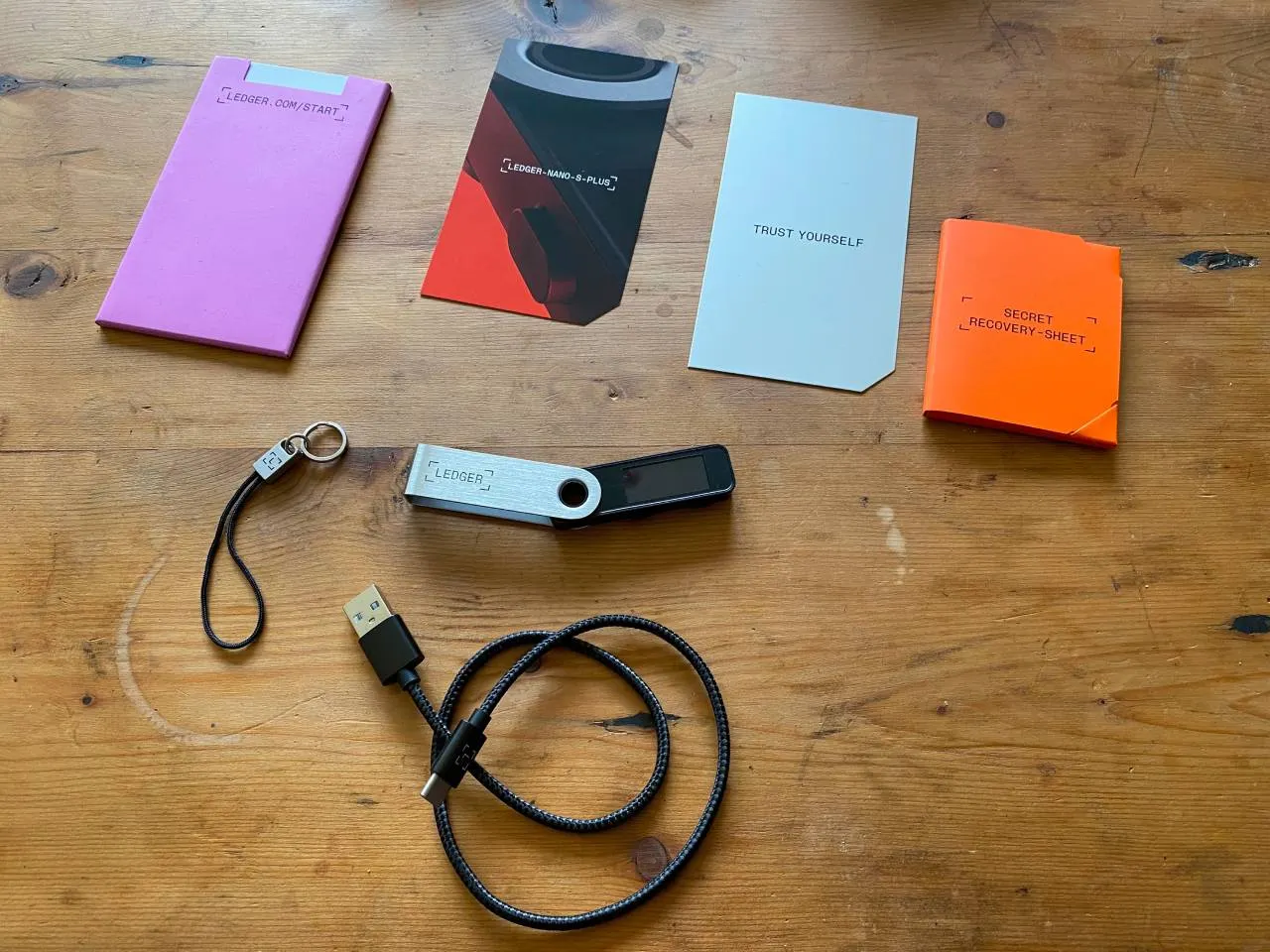
Everything feels high-quality—the USB-C cable is braided, the packaging is well-designed and there are jazzy accent colors everywhere (you're not going to misplace that bright orange recovery phrase envelope, that's for sure, unless you accidentally throw it out).
Ledger Nano S Plus: Getting Started
To set up the Ledger Nano S Plus, you'll first need to navigate to Ledger's website on your computer and download the Ledger Live application, which will require you to set up a password.
Once you've done that, you'll need to connect your Ledger to your computer.

While Ledger Live provides a handy walkthrough for beginners, the bulk of the setup steps are performed on the device itself. First, you'll need to choose whether you're setting it up as a new device, or restoring it from a recovery phrase. Then, you'll need to set up a PIN.
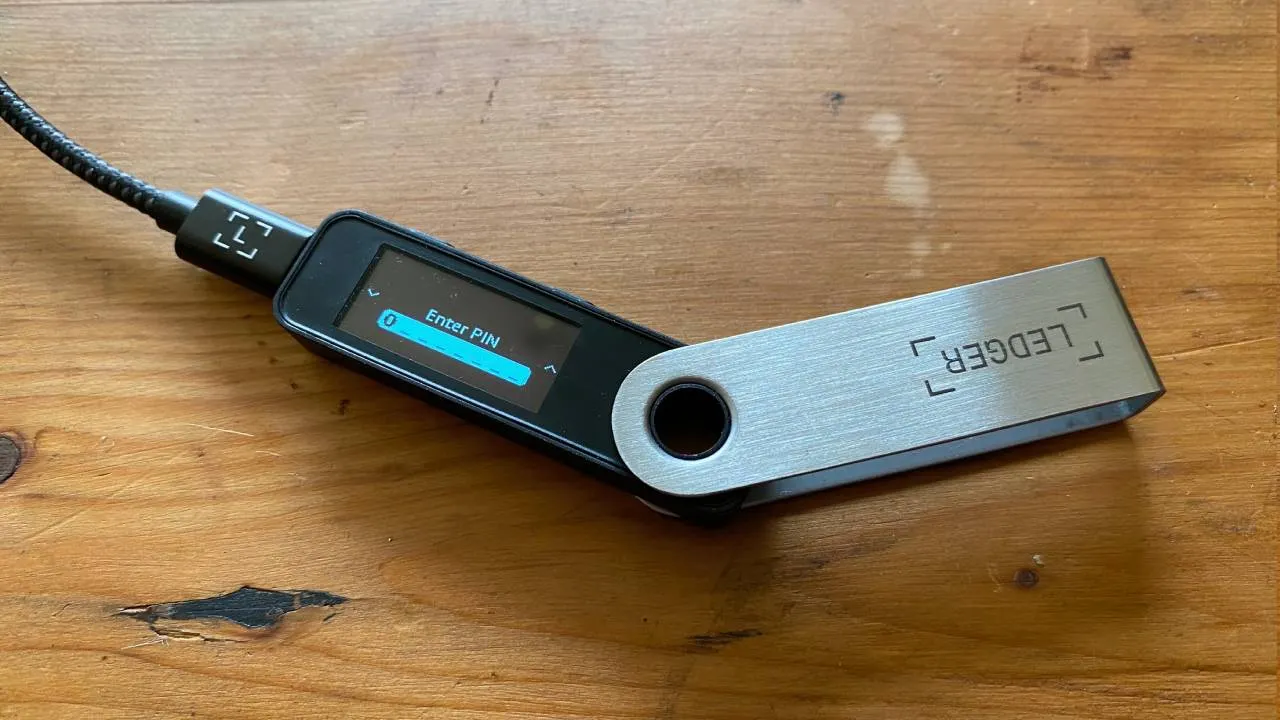
To navigate through the menus, you use the two buttons on top of the device; clicking both buttons simultaneously selects the current option.
If you're setting the Nano S Plus up as a new device, you'll be prompted to note down your 24-word recovery phrase, then verify each word in turn. This is a laborious, but necessary, process; technically speaking the 24-word phrase is your wallet; the Ledger device itself is just a means of accessing it.
As Ledger repeatedly tells you, that means if you lose your recovery phrase, you lose access to the funds in your wallet; Ledger has no way to help you.
For the same reason, you should never, ever share your recovery phrase with anyone, enter it into any apps or websites, take a photo of it, or save it to cloud storage. Anyone who has those 24 words has access to your wallet and all the funds in it.
Once your device is set up, you can connect to Ledger Live, where you'll be prompted to verify that it's a genuine Ledger device.

Ledger Nano S Plus Review: Ledger Live
Your main point of interaction with the Ledger Nano S Plus will be the desktop Ledger Live software, which is a nicely-designed, streamlined affair.
Like the Nano S, the Nano S Plus doesn't have the Bluetooth connectivity and internal battery found in the Nano X, meaning you'll need to connect it to your computer using a USB-C cable. The one supplied in the box is a lot nicer than the flimsy micro-USB cable that came with the Nano S, but it's a bit short—clearly aimed with laptop users in mind rather than desktop owners.
You can also buy a Ledger OTG kit (or use an appropriate cable) to connect your device to an Android phone using the Ledger Live app; iOS users are out of luck, however.
To add apps to your newly-installed Ledger, you'll need to click on "Manager" in the left-hand sidebar of Ledger Live. You'll then be prompted to "Allow Ledger Manager" on the hardware wallet itself. From there, you can check that your device is running the latest firmware, update it if it isn't, and add or update apps.
Apps effectively represent cryptocurrencies, such as Bitcoin and Ethereum. Installing an app prompts you to add an account, which appears in the "portfolio" section of Ledger Live.
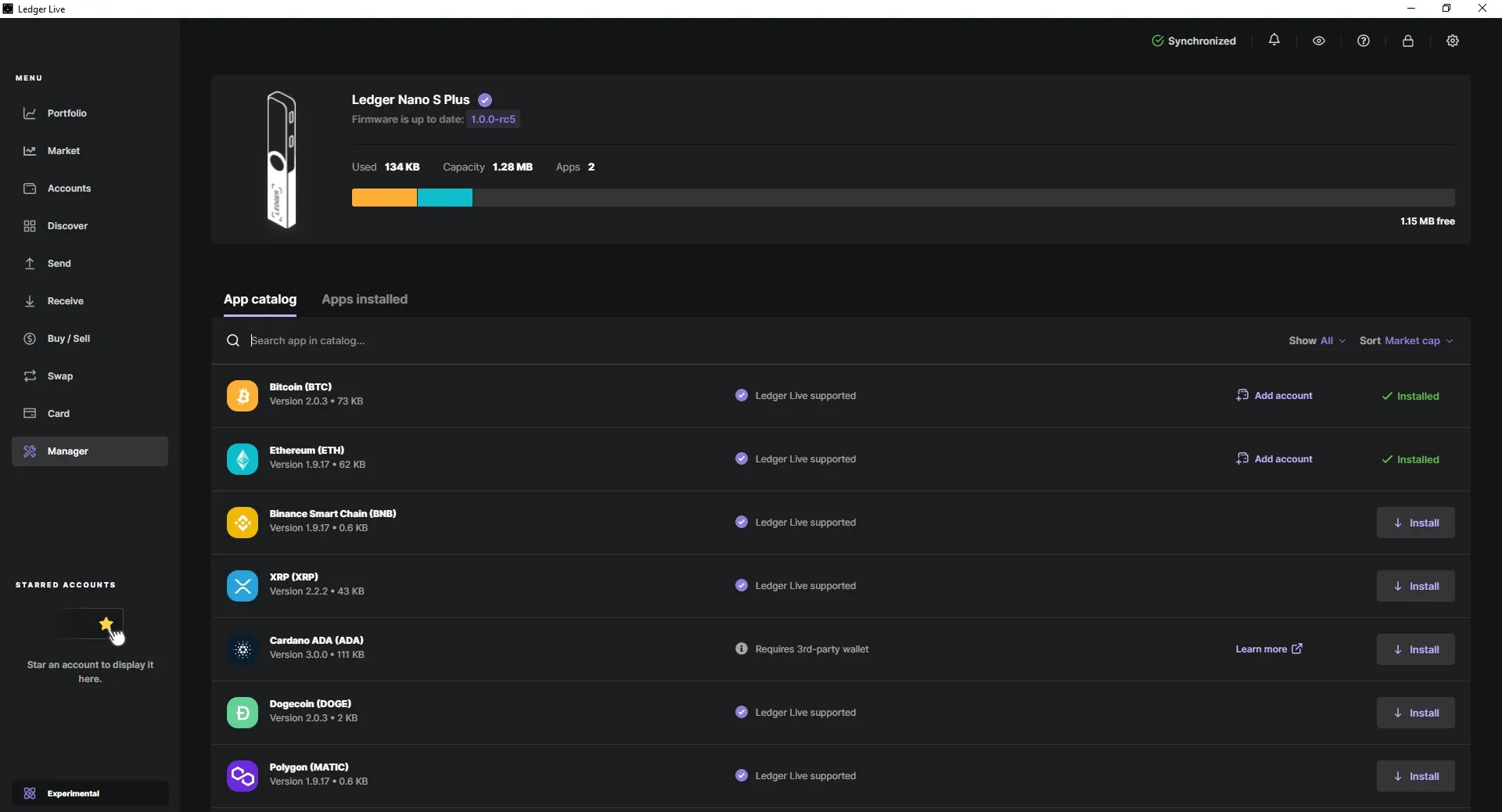
With your apps installed, you can buy crypto directly through the Ledger Live app's "buy/sell" option using their supported providers, or send and receive crypto. This entails navigating to the "accounts" section of Ledger Live and clicking on the relevant account, or using the "send" and "receive" buttons in the sidebar.
You'll also need to open the app for the crypto in question on your Nano S Plus.
Sending or receiving crypto prompts you to confirm the sending or receiving address on your Nano S Plus device. Even with the bigger screen, it can be a fiddly affair, though at least you no longer have to click through multiple screens to see the whole address.
Ledger Nano S Plus: features and assets
As well as Ledger Live, you can also use the Nano S Plus with over 50 web wallets such as MetaMask, MyEtherWallet and MyCrypto.
The Nano S Plus supports the same 5,500+ coins and tokens as the Ledger Nano S and X models, via Ledger Live.
These include, among others:
- Bitcoin (BTC)
- Ethereum (ETH) and ERC-20 tokens
- Dogecoin (DOGE)
- XRP
- BNB Chain
- Cardano (ADA)
- Polygon (MATIC)
- Litecoin (LTC)
- Tron (TRX)
- Bitcoin Cash (BCH)
- Algorand (ALGO)
- Stellar (XLM)
- Zcash (ZEC)
- Cosmos (ATOM)
The original Nano S could only store up to three apps on the device at any given time—which was fair enough in 2016, when the number of cryptocurrencies was limited. Nowadays, with thousands of assets available, that's not sustainable; happily, the Nano S Plus sports a much healthier 1.5MB storage capacity, allowing for multiple apps to be stored on the device simultaneously (though only about 1.28MB is actually available for apps).
Ledger Nano S Plus: Security
The Nano S Plus sports the same security credentials as its Ledger stablemates; that is to say, a physically isolated secure element that's CC EAL 5+ certified. That means they've been independently certified by a third party to the same standard as the secure elements used in credit cards, passports and SIM cards; EAL 5+ is considered the highest level of security against penetration tests.
The Nano S Plus and its stablemates are also the only hardware wallets to receive CSPN (First Level Security Certificate) certification, from ANSSI—the National Cybersecurity Agency of France.
Ledger devices use a proprietary operating system, BOLOS, that requires users to verify transactions on the hardware wallet itself, while displaying the transaction details on-device. This ensures that should your computer be compromised, the Ledger will still show the correct transaction details.
The company runs bounty programs to identify vulnerabilities in its products, and maintains an in-house "attack lab," the Ledger Donjon.
For the extremely security-conscious user, the Nano S Plus also requires a physical connection to a computer or mobile device, unlike the premium Nano X model. While Ledger maintains that the Nano X's Bluetooth connection is only used to transport public data, and that wallet private keys and the seed remain in the device's secure element, for some users Bluetooth connectivity represents a potential vulnerability too far.
For these users, the Nano S Plus offers a neat compromise between the hardware upgrades of the Nano X while maintaining the physical-only connection of the Nano S.
While Ledger's on-device security is extremely tight, the company has suffered some security lapses, notably in June 2020 when over a million customer records were leaked from an e-commerce database. Ledger subsequently committed to changing its procedures for handling customer data, but it remains an embarrassing blot on the company's record.
Ledger Nano S Plus review: Verdict
Ledger's base-model hardware wallet was long overdue for a refresh. With the Nano S Plus, it's achieved a balance between overhauling outdated components without resorting to the (some would say, unnecessary) bells and whistles of the premium Nano X model.
Unless you desperately want the convenience of Bluetooth connectivity, or the ability to use your Ledger with iOS devices, the Nano S Plus is the only device you'll need. And with its enlarged screen and increased storage capacity, it's leagues ahead of its predecessor the Nano S.
For most users, the Nano S Plus is an ideal storage solution for your digital asset portfolio, and comfortably ranks among the best hardware wallets in the market.





